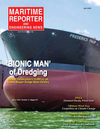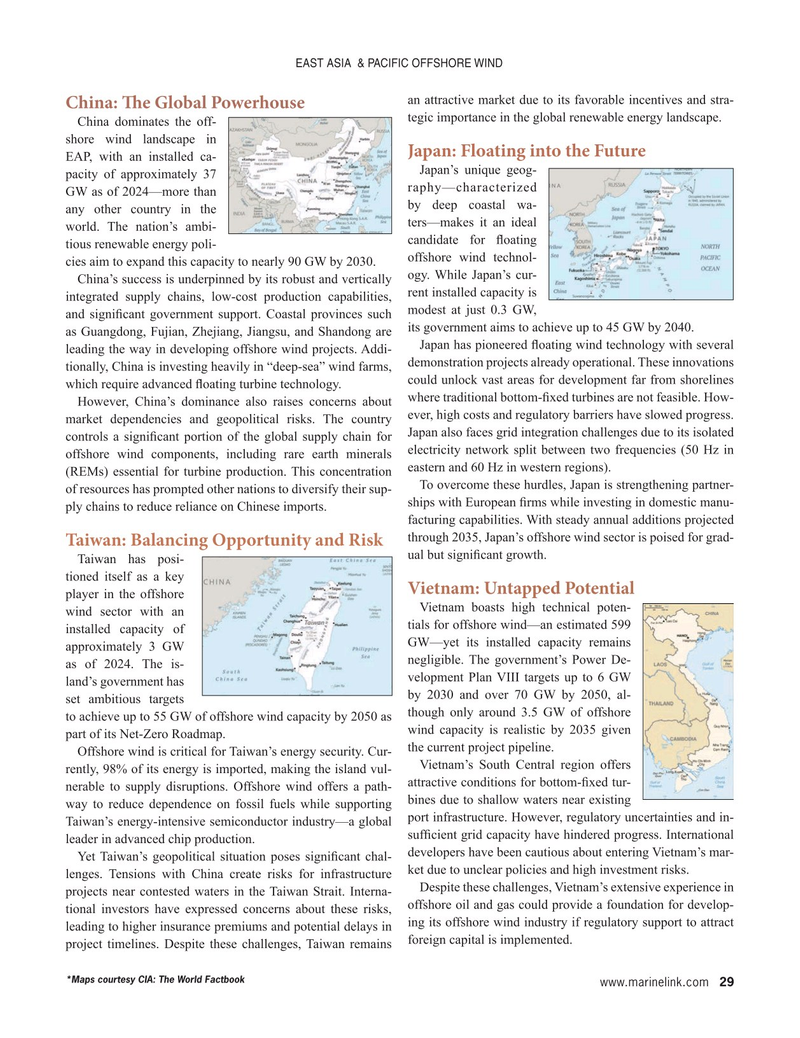
Page 29: of Maritime Reporter Magazine (April 2025)
Read this page in Pdf, Flash or Html5 edition of April 2025 Maritime Reporter Magazine
EAST ASIA & PACIFIC OFFSHORE WIND an attractive market due to its favorable incentives and stra-
China: T e Global Powerhouse tegic importance in the global renewable energy landscape.
China dominates the off- shore wind landscape in
Japan: Floating into the Future
EAP, with an installed ca-
Japan’s unique geog- pacity of approximately 37 raphy—characterized
GW as of 2024—more than by deep coastal wa- any other country in the ters—makes it an ideal world. The nation’s ambi- candidate for ? oating tious renewable energy poli- offshore wind technol- cies aim to expand this capacity to nearly 90 GW by 2030.
China’s success is underpinned by its robust and vertically ogy. While Japan’s cur- integrated supply chains, low-cost production capabilities, rent installed capacity is and signi? cant government support. Coastal provinces such modest at just 0.3 GW, as Guangdong, Fujian, Zhejiang, Jiangsu, and Shandong are its government aims to achieve up to 45 GW by 2040.
Japan has pioneered ? oating wind technology with several leading the way in developing offshore wind projects. Addi- tionally, China is investing heavily in “deep-sea” wind farms, demonstration projects already operational. These innovations could unlock vast areas for development far from shorelines which require advanced ? oating turbine technology.
However, China’s dominance also raises concerns about where traditional bottom-? xed turbines are not feasible. How- market dependencies and geopolitical risks. The country ever, high costs and regulatory barriers have slowed progress. controls a signi? cant portion of the global supply chain for Japan also faces grid integration challenges due to its isolated offshore wind components, including rare earth minerals electricity network split between two frequencies (50 Hz in (REMs) essential for turbine production. This concentration eastern and 60 Hz in western regions).
To overcome these hurdles, Japan is strengthening partner- of resources has prompted other nations to diversify their sup- ships with European ? rms while investing in domestic manu- ply chains to reduce reliance on Chinese imports. facturing capabilities. With steady annual additions projected through 2035, Japan’s offshore wind sector is poised for grad-
Taiwan: Balancing Opportunity and Risk ual but signi? cant growth.
Taiwan has posi- tioned itself as a key
Vietnam: Untapped Potential player in the offshore
Vietnam boasts high technical poten- wind sector with an tials for offshore wind—an estimated 599 installed capacity of
GW—yet its installed capacity remains approximately 3 GW negligible. The government’s Power De- as of 2024. The is- velopment Plan VIII targets up to 6 GW land’s government has by 2030 and over 70 GW by 2050, al- set ambitious targets to achieve up to 55 GW of offshore wind capacity by 2050 as though only around 3.5 GW of offshore wind capacity is realistic by 2035 given part of its Net-Zero Roadmap. the current project pipeline.
Offshore wind is critical for Taiwan’s energy security. Cur-
Vietnam’s South Central region offers rently, 98% of its energy is imported, making the island vul- attractive conditions for bottom-? xed tur- nerable to supply disruptions. Offshore wind offers a path- way to reduce dependence on fossil fuels while supporting bines due to shallow waters near existing
Taiwan’s energy-intensive semiconductor industry—a global port infrastructure. However, regulatory uncertainties and in- suf? cient grid capacity have hindered progress. International leader in advanced chip production. developers have been cautious about entering Vietnam’s mar-
Yet Taiwan’s geopolitical situation poses signi? cant chal- lenges. Tensions with China create risks for infrastructure ket due to unclear policies and high investment risks.
Despite these challenges, Vietnam’s extensive experience in projects near contested waters in the Taiwan Strait. Interna- tional investors have expressed concerns about these risks, offshore oil and gas could provide a foundation for develop- leading to higher insurance premiums and potential delays in ing its offshore wind industry if regulatory support to attract project timelines. Despite these challenges, Taiwan remains foreign capital is implemented.
*Maps courtesy CIA: The World Factbook www.marinelink.com 29
MR #4 (18-33).indd 29 4/2/2025 9:04:44 AM

 28
28

 30
30
